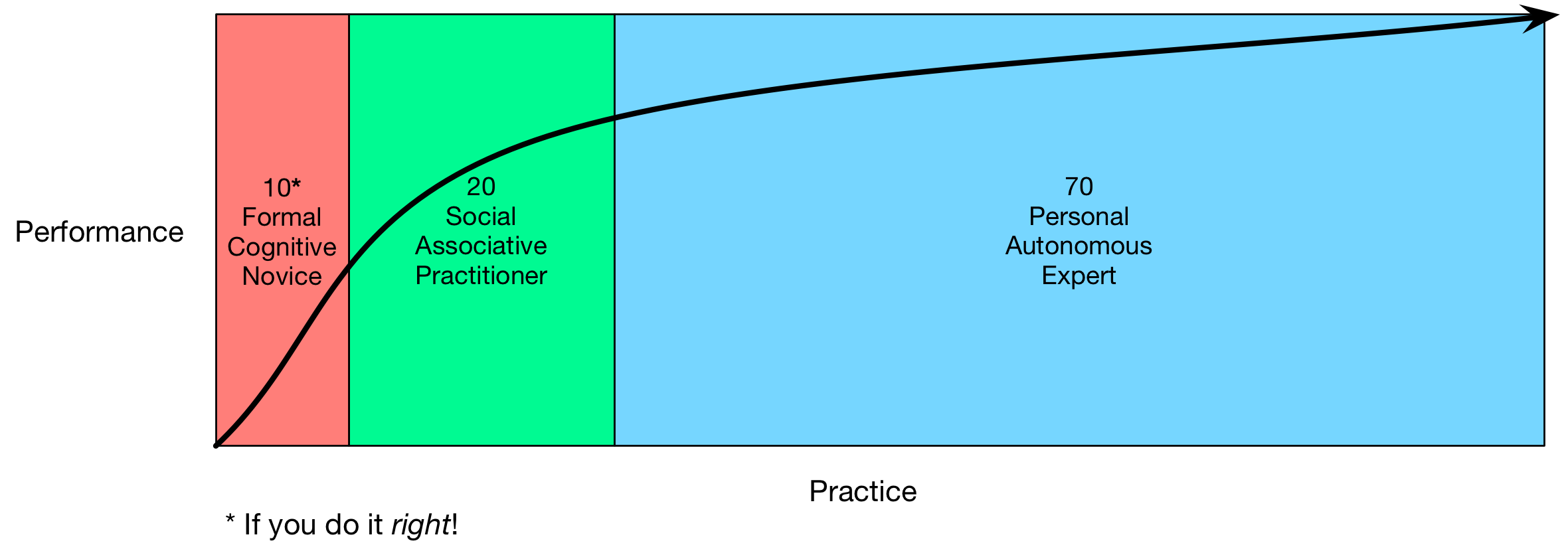My colleague Charles Jennings recently posted on the value of autonomous learning (worth reading!), sparked by a diagram provided by another ITA colleague, Jane Hart (that I also thought was insightful). In Charles’ post he also included an IBM diagram that triggered some associations.
So, in IBM’s diagram, they talked about: the access phase where learning is separate, the integration where learning is ‘enabled’ by work, and the on-demand phase where learning is ’embedded’. They talked about ‘point solutions’ (read: courses) for access, then blended models for integration, and dynamic models for on demand. The point was that the closer to the work that learning is, the more value.
However, I was reminded of Fits & Posner’s model of skill acquisition, which has 3 phases of cognitive, associative, and autonomous learning. The first, cognitive, is when you benefit from formal instruction: giving you models and practice opportunities to map actions to an explicit framework. (Note that this assumes a good formal learning design, not rote information and knowledge test!) Then there’s an associative stage where that explicit framework is supported in being contextualized and compiled away. Finally, the learner continues to improve through continual practice.
I was initially reminded of Norman & Rumelhart’s accretion, restructuring, and tuning learning mechanisms, but it’s not quite right. Still, you could think of accreting the cognitive and explicitly semantic knowledge, then restructuring that into coarse skills that don’t require as much conscious effort, until it becomes a matter of tuning a finely automated skill.
 This, to me, maps more closely to 70:20:10, because you can see the formal (10) playing a role to kick off the semantic part of the learning, then coaching and mentoring (the 20) support the integration or association of the skills, and then the 70 (practice, reflection, and personal knowledge mastery including informal social learning) takes over, and I mapped it against a hypothetical improvement curve.
This, to me, maps more closely to 70:20:10, because you can see the formal (10) playing a role to kick off the semantic part of the learning, then coaching and mentoring (the 20) support the integration or association of the skills, and then the 70 (practice, reflection, and personal knowledge mastery including informal social learning) takes over, and I mapped it against a hypothetical improvement curve.
Of course, it’s not quite this clean. While the formal often does kick off the learning, the role of coaching/mentoring and the personal learning are typically intermingled (though the role shifts from mentor to mentee ;). And, of course, the ratios in 70:20:10 are only a framework for rethinking investment, not a prescription about how you apply the numbers. And I may well have the curve wrong (this is too flat for the normal power law of learning), but I wanted to emphasize that the 10 only has a small role to play in moving performance from zero to some minimal level, that mentoring and coaching really help improve performance, and that ongoing development requires a supportive environment.
I think it’s important to understand how we learn, so we can align our uses of technology to support them in productive ways. As this suggests, if you care about organizational performance, you are going to want to support more than the course, as well as doing the course right. (Hence the revolution. :)
#itashare
[…] 70:20:10 and the Learning Curve CLARK QUINNÂ Â |Â TUESDAY, JANUARY 27, 2015 […]